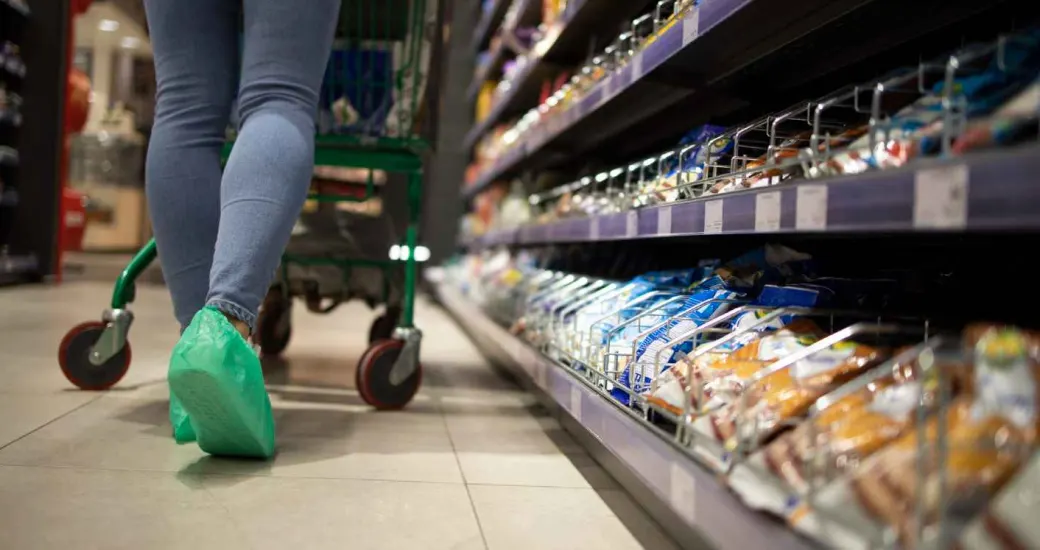The e-commerce revolution has changed shopping methods globally. The concept of Endless Aisle is completely changing and redefining traditional shopping paradigms. This strategy allows retailers to go beyond physical space limitations, offering customers an extensive product selection through seamless integration of online and in-person shopping experiences.
This blog will dissect the driving forces behind the adoption of endless aisles. From shifts in retail space limitations to the benefits of the endless aisle and the challenges associated with meeting the growing consumer expectation for diverse product offerings, we will learn how this approach addresses inventory challenges while increasing customer satisfaction.
What are the Endless Aisle in Retail?
The concept of ordering items online for customers who visit a store physically is known as Endless aisles. Items that are out of stock or not available for takeaway, customers can order them in-store and delivered it to their address a few days later. For the same reason, it is also known as “buy in the store, ship to the customer” (BOPIS).
Offering an endless aisle in your retail store is like having all your online products available in the physical store. It is the opposite of the "buy online, pick up in-store" option.
You can let customers buy in-store and ship to their homes in a few ways. They can either make the purchase in-store and have it delivered, or store associates can create a virtual shopping cart. The cart can be finalized in-store for home delivery or sent to the customer's email so they can complete the purchase online later.
What are the benefits of an endless aisle?
Lower Inventory costs
Suppose you run a retail shop that operates both online and offline. In that case, endless aisles make it easy for you to sell product catalogs without maintaining an inventory for every item at every store location. By integrating this concept, strategies like just-in-time inventory become more feasible for traditional retailers.
Alternatively, you can store inventory in your warehouse or at more prominent store outlets with ample shelf space or with third-party fulfillment centers such as the Shopify Fulfillment Network to ship products directly to your customers. All three methods provide in-store customers with expanded access to your product range without introducing complexities to your inventory management.
Customer loyalty
Diversifying the product selection in your physical stores gives customers more choices and reduces the likelihood of them seeking alternatives elsewhere.
As per research, if a product is out of stock, 37% of in-store shoppers may go to a different store, and almost half would abandon their purchase altogether. Implementing the "endless aisle" strategy helps you capitalize on the initial buyer intent, this will keep customers engaged without losing sales due to low stock.
Moreover, you enhance the chances of cultivating future online shoppers by educating customers about your online offerings and providing a seamless user experience, from order placement to delivery.
Reduce online returns
When comparing online and physical retail, a significant differentiator is return rates, with e-commerce encountering 11% higher returns than brick-and-mortar stores. This difference arose since online shoppers cannot physically engage with products prior to purchase.
As per Jessica Kats, an expert in e-commerce and retail at Soxy, the introduction of endless aisles effectively addresses this challenge. With this option, Soxy has observed a reduction in returns and exchanges. The approach lets customer assess product quality and suitability in-store, ensuring that the delivered order precisely aligns with their expectations.
Jessica also highlights the positive impact on Soxy's customer satisfaction and retention metrics, noting that around 27% of in-store shoppers opt for the buy-in-store, ship-to-customer alternative. This percentage rises to 41% during the holiday season.
Competitive advantage
The retailer gets a competitive advantage with endless aisles, it helps them stand out from other brick-and-mortar stores with limited inventory space. Endless Aisle helps to attract more customers.
The challenges of endless aisle
Inventory Management Difficulties
It can be challenging to manage an inventory with many products available. Retailers must ensure accurate availability and shipping times information to avoid stockouts or delivery delays.
Cost
Implementing tactics like endless aisles demands significant investments in technology and infrastructure for adequate inventory, logistics, and customer data management, potentially increasing overall costs.
Logistics
The complex logistics of endless aisles necessitate robust systems for order tracking, returns, and customer inquiries, requiring substantial investments in technology and infrastructure.
Implementation and Data Accuracy
Ensuring a positive customer experience entails accurate and up-to-date online product data, including descriptions, images, and pricing. Inaccuracies can lead to customer dissatisfaction and returns.
How to Implement endless aisles in retail?
- Identify Products: Retailers should choose which products to include in their endless aisles, considering items not typically found in physical stores and those popular among online shoppers.
- Build Supplier Relationships: Retailers must establish good relationships with multiple suppliers or manufacturers. This involves negotiating contracts, maintaining positive partnerships, and ensuring timely and high-quality product deliveries.
- Invest in Technology and Infrastructure: Managing endless aisles requires a significant investment in technology and infrastructure. Retailers should consider adopting an e-commerce platform supporting endless aisles, efficient inventory management systems, reliable shipping and fulfillment capabilities, and analytics tools for customer data.
- Ensure Accurate Product Information: A positive customer experience hinges on accurate and up-to-date online product information, including descriptions, images, and pricing. Retailers should establish processes for regular updates and quick error corrections.
- Monitor and Adjust Strategies: Following the launch of endless aisles, retailers should track key performance metrics, including sales, inventory levels, shipping costs, and customer satisfaction. Being flexible allows for the adjustment of strategies as needed.
Top 3 Endless Aisle Strategies in Retail
Here are our top 3 endless aisle strategies to facilitate online orders on behalf of in-store shoppers:
Interactive kiosks
Interactive kiosks, also known as touch-screen interfaces or virtual shelves, provide an engaging in-store experience for shoppers. These user-friendly platforms empower customers to explore an extensive online product catalog, delve into detailed item specifications, and conveniently place orders for home delivery.
A notable advantage of incorporating in-store kiosks lies in the autonomy they offer to shoppers, enabling them to independently navigate tasks without relying on assistance from retail store associates. This enhances the customer experience and presents an opportunity for cost savings. The streamlined approach, requiring less physical space for offline shopper service and a leaner staff, contributes to efficient cost management and positively impacts overall profitability.
For the integration of these interactive kiosks featuring state-of-the-art virtual shelf technology, consider exploring solutions provided by:
Showrooming
60% of consumers expect retailers to offer more floor space to experiences than products by 2025. To meet this evolving demand, brands strategically invest in experiential retail initiatives.
Showrooming involves an endless aisle strategy, where customers explore products in-store but complete their purchases online. Two key methods identified for implementing showrooming are:
QR codes: Shoppers utilize their mobile phone cameras to scan QR codes on product price tags or display signage, effortlessly navigating to the specific product page. Implementation is straightforward, requiring tools like Shopcodes or any QR code generator.
Email carts: Store associates proactively compile items into a shopper's cart as they browse, sending a virtual cart to the shopper's email for a convenient review and purchase. If the transaction is completed online, the associate and the store location receive due credit for the purchase.
Showrooming's effectiveness lies in allowing shoppers to finalize their purchases through mobile phones. Almost three-quarters of US shoppers use mobile devices during in-store shopping, so this approach has gained considerable popularity. Notably, 63% of retailers anticipated the widespread adoption of customer-owned mobile point-of-sale checkout, including endless aisles, by 2022.
Order fulfillment
Retailers can effectively implement an endless aisle strategy without stocking products on-site. Instead of using interactive kiosks, they can opt for dropshipping out-of-stock items directly to the customer's address. In this process, the retailer takes the customer's order at a physical store through their online platform, and the order details are forwarded to a third-party supplier. The supplier's duty is to handle the product's picking, packing, and shipping.
The main advantage of this strategy is providing customers with a seamless experience. They can access a diverse range of products without dealing with multiple suppliers, all while making purchases through the retailer's store. Moreover, retailers can benefit from a diverse inventory without needing physical storage space, making it feasible for even smaller stores.
However, when partnering with third-party providers to stock endless aisles, caution is advised. Before launching a partnership, research potential partners, conduct test runs, and establish a reliable process. It is crucial to remember that customers associate the experience with the retail business, so making a positive impression is key to maintaining and enhancing the brand's reputation.
Conclusion
Now we know how Endless Aisle is completely changing and redefining traditional shopping paradigms. The endless aisle has changed how consumers shop online. Retailers now offer products that may not be available in their physical stores. With endless aisles, retailers can provide an extensive selection of products that may not be available in their physical stores.
Furthermore, the incorporation of endless aisles can boost sales and revenue for retailers by expanding their reach to a broader audience and presenting products that customers may have yet to consider purchasing. The implementation of endless aisles poses certain challenges. Managing inventory, optimizing logistics, and ensuring a seamless and user-friendly customer shopping experience are pivotal considerations. Additionally, not all retailers may find endless aisles suitable, particularly those with limited resources or catering to a niche target market.
Despite these challenges, the undeniable benefits of endless aisles suggest that retailers adopting this method will gain the upper hand from the competition.
Subscribe to Saffron Tech
Explore your marketing zen with our newsletter! Subscribe now.



